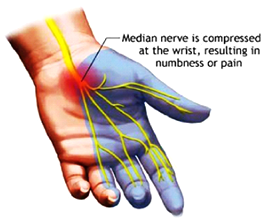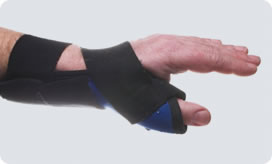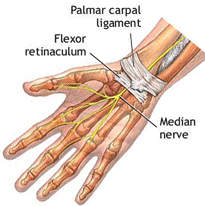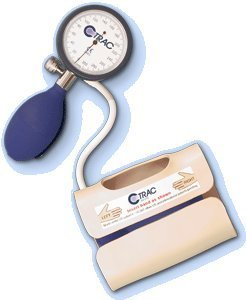Carpal Tunnel Syndrome
Symptoms
 The symptoms of carpal tunnel syndrome (CTS) are tingling and numbness in the hand and fingers, pain in the hand and arm and weak grip;
you may have some or all of these symptoms. Numbness and pain are often worse at night and sometimes when working at a keyboard.
The symptoms of carpal tunnel syndrome (CTS) are tingling and numbness in the hand and fingers, pain in the hand and arm and weak grip;
you may have some or all of these symptoms. Numbness and pain are often worse at night and sometimes when working at a keyboard.
The carpal tunnel is a space between the bones of the wrist and a thick ligament. CTS occurs when the median nerve, one of the main nerves to the hand, is squashed in the carpal tunnel, at the wrist.
The condition most often occurs without any clear cause, but can occur during the later stages of pregnancy or with certain medical conditions.
The diagnosis of CTS can usually be made in the clinic as the symptoms and signs on examination are often typical. When there is any doubt, an electrical test called nerve conduction test is required; this will establish the diagnosis.
Treatment
 Treatment of CTS depends on the severity and duration of the problem. In mild cases of short duration, and particularly in CTS that occurs
in pregnancy, CTS is usually treated without surgery. A wrist splint worn at night in most cases improves or relieves symptoms and helps
you to get a good night sleep. A steroid injection at the wrist may be considered although this may not be a permanent solution to the problem.
Treatment of CTS depends on the severity and duration of the problem. In mild cases of short duration, and particularly in CTS that occurs
in pregnancy, CTS is usually treated without surgery. A wrist splint worn at night in most cases improves or relieves symptoms and helps
you to get a good night sleep. A steroid injection at the wrist may be considered although this may not be a permanent solution to the problem.
After Surgery
 Surgery is recommended for more severe or longstanding cases of CTS. The operation is called carpal tunnel decompression and is a very
minor procedure that is usually done under local anaesthetic (you are awake throughout); it takes about 20 minutes to do. Carpal tunnel
decompression involves cutting through a tight ligament that the nerve passes beneath; this is where the nerve is squashed. The incision
is made on the palm of the hand near the wrist and is 3-4cm long. The wound is stitched (I use the type of stitches that need to be
removed), a dressing and wrist splint is applied.
Surgery is recommended for more severe or longstanding cases of CTS. The operation is called carpal tunnel decompression and is a very
minor procedure that is usually done under local anaesthetic (you are awake throughout); it takes about 20 minutes to do. Carpal tunnel
decompression involves cutting through a tight ligament that the nerve passes beneath; this is where the nerve is squashed. The incision
is made on the palm of the hand near the wrist and is 3-4cm long. The wound is stitched (I use the type of stitches that need to be
removed), a dressing and wrist splint is applied.
After surgery the hand is rather out of action for a few days although you will be able to use the hand to do essential things. The splint is removed 2-4 days after surgery and only a small adhesive dressing is then required. My hand therapist will do this and help with some simple exercises to get you back to using the hand in the shortest time. Stitches are removed at about 10 days after surgery. Patients who do desk type work will typically be able to return to work within a week of surgery and you can drive at this stage also. Patients whose work is more manual may return to work at 2-3 weeks after surgery.
Surgical treatment is usually very effective. In very severe or longstanding cases (2 years) symptoms are more often improved than relieved. Serious complications are extremely uncommon. The most frequent problem after surgery is some tenderness of the scar. This will settle with scar massage (my hand therapist will help with this).
Other Treatments
 A device called the C-trac has
been developed that slowly stretches the ligament that is responsible for squashing the nerve. At the present time there is not strong
evidence for the efficacy of the C-trac, but for some patients with mild symptoms or those who do not wish to have any of the conventional
medical treatments it may be suitable.
A device called the C-trac has
been developed that slowly stretches the ligament that is responsible for squashing the nerve. At the present time there is not strong
evidence for the efficacy of the C-trac, but for some patients with mild symptoms or those who do not wish to have any of the conventional
medical treatments it may be suitable.


